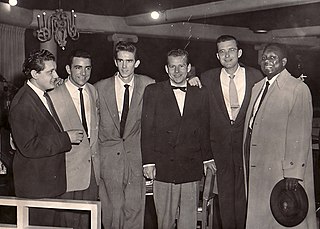Related Research Articles

In music, a cadenza is, generically, an improvised or written-out ornamental passage played or sung by a soloist or soloists, usually in a "free" rhythmic style, and often allowing virtuosic display. During this time the accompaniment will rest, or sustain a note or chord. Thus an improvised cadenza is indicated in written notation by a fermata in all parts. A cadenza will usually occur over the final or penultimate note in a piece, the lead-in or over the final or penultimate note in an important subsection of a piece. It can also be found before a final coda or ritornello.

Orchestration is the study or practice of writing music for an orchestra or of adapting music composed for another medium for an orchestra. Also called "instrumentation", orchestration is the assignment of different instruments to play the different parts of a musical work. For example, a work for solo piano could be adapted and orchestrated so that an orchestra could perform the piece, or a concert band piece could be orchestrated for a symphony orchestra.

Benjamin David Goodman was an American jazz clarinetist and bandleader known as the "King of Swing".

A big band is a type of musical ensemble of jazz music that usually consists of ten or more musicians with four sections: saxophones, trumpets, trombones, and a rhythm section. Big bands originated during the early 1910s and dominated jazz in the early 1940s when swing was most popular. The term "big band" is also used to describe a genre of music, although this was not the only style of music played by big bands.

Alton Glenn Miller was an American big-band trombonist, arranger, composer, and bandleader in the swing era. He was the best-selling recording artist from 1939 to 1942, leading one of the best-known big bands. Miller's recordings include "In the Mood", "Moonlight Serenade", "Pennsylvania 6-5000", "Chattanooga Choo Choo", "A String of Pearls", "At Last", "(I've Got a Gal In) Kalamazoo", "American Patrol", "Tuxedo Junction", "Elmer's Tune", and "Little Brown Jug". In just four years Glenn Miller scored 16 number-one records and 69 top ten hits—more than Elvis Presley and the Beatles did in their careers.

Rhapsody in Blue is a 1924 musical composition by the American composer George Gershwin for solo piano and jazz band, which synthesizes elements of classical music with jazz-influenced effects. The composition was commissioned at the request of bandleader Paul Whiteman. The piece received its premiere in the concert, "An Experiment in Modern Music," which was held on February 12, 1924, in Aeolian Hall, New York City, by Whiteman and his band with Gershwin playing the piano. The work was orchestrated by Ferde Grofé several times, including the original 1924 scoring, the 1926 "theater orchestra" setting, and the 1942 symphony orchestra scoring.

Artie Shaw was an American clarinetist, composer, bandleader, actor and author of both fiction and non-fiction.

Boléro is a one-movement orchestral piece by the French composer Maurice Ravel (1875–1937). Originally composed as a ballet commissioned by Russian actress and dancer Ida Rubinstein, the piece, which premiered in 1928, is Ravel's most famous musical composition.

Harry Howell Carney was a jazz saxophonist and clarinettist who spent over four decades as a member of the Duke Ellington Orchestra. He played a variety of instruments but primarily used the baritone saxophone, being a critical influence on the instrument in jazz.

Also sprach Zarathustra, Op. 30 is a tone poem by Richard Strauss, composed in 1896 and inspired by Friedrich Nietzsche's philosophical 1883-1885 novel Thus Spoke Zarathustra. The composer conducted its first performance on 27 November 1896 in Frankfurt. A typical performance lasts half an hour.

Prelude, Fugue and Riffs is a "written-out" jazz-in-concert-hall composition composed by Leonard Bernstein for a jazz ensemble featuring solo clarinet.

Prélude à l'après-midi d'un faune, known in English as Prelude to the Afternoon of a Faun, is a symphonic poem for orchestra by Claude Debussy, approximately 10 minutes in duration. It was composed in 1894 and first performed in Paris on 22 December 1894, conducted by Gustave Doret. The flute solo was played by Georges Barrère.
Derek Bermel is an American composer, clarinetist and conductor whose music blends various facets of world music, funk and jazz with largely classical performing forces and musical vocabulary. He is the recipient of various awards including a Guggenheim Fellowship and the American Academy in Rome's Rome Prize awarded to artists for a year-long residency in Rome.
Aaron Copland's Clarinet Concerto was written between 1947 and 1949, although a first version was available in 1948. The concerto was later choreographed by Jerome Robbins for the ballet Pied Piper (1951).
Walt Levinsky was an American big band and orchestral player, composer, arranger and bandleader. While many of his big band assignments were as lead alto sax player, his favorite instrument was the clarinet.
Third stream is a music genre that is a fusion of jazz and classical music. The term was coined in 1957 by composer Gunther Schuller in a lecture at Brandeis University. Improvisation is generally seen as a vital component of third stream.

"Harlem Chapel Chimes" is a 1935 jazz instrumental composed by Glenn Miller. The song was released as an A-side 78 single by the Dorsey Brothers Orchestra.

Clarinet Marmalade, later Clarinet Marmalade Blues, is a 1918 dixieland jazz standard composed by Larry Shields and Henry Ragas of the Original Dixieland Jass Band. It is played in the key of F major. It was recorded by Fletcher Henderson in 1926 and Frankie Trumbauer in 1927.
Three Pieces for Solo Clarinet is a solo instrumental work by Igor Stravinsky. It was published in 1919, shortly after the completion of his Suite from L'Histoire du Soldat, as a thank-you gift to the philanthropist and arts patron Werner Reinhart, who was also an amateur clarinetist. The Three Pieces is perhaps the most well-known work for unaccompanied clarinet in the repertoire. It is also notable for being one of the few clarinet solo pieces that calls for clarinets in both B♭ and A.